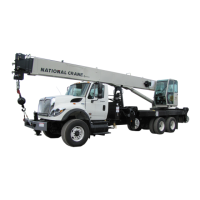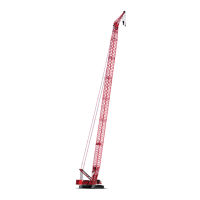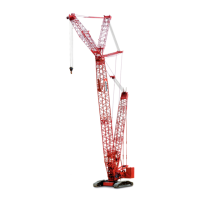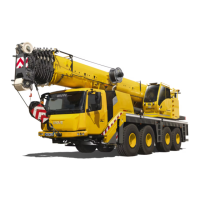National Crane 1-21-2019 Control # 104-07 8-3
1400A SERVICE MANUAL LUBRICATION
Arctic Hydraulic Oil
Temperature Down to -9°C (15°F) to -29°C (-20°F)
For colder operating conditions, the standard fluid may be
replaced with a petroleum based fluid developed especially
for colder environments.
Temperature Down to -40°C (-40°F) and Below
Petroleum based fluids developed especially for low
temperature service may be used with satisfactory results.
However, certain fluids, such as hologenated hydrocarbons,
nitro hydrocabons and phosphate ester hydraulic fluids
might not be compatible with hydraulic system seals and
wear bands. Arctic hydraulic oil is not recommended for
service in ambient temperatures above 0°C (32°F).
If you are in doubt about the suitability of a specific fluid,
check with your authorized National Crane distributor or
Manitowoc Crane Care.
NOTE: All fluids and lubricants may be purchased by
contacting the Manitowoc Crane Care Parts
Department.
Hydraulic Oil Inspection
Environmental and other conditions can dramatically affect
the condition of hydraulic oil and filters. Therefore, specific
intervals for servicing/changing hydraulic oil, filters and
hydraulic tank breathers cannot be set. However, it is
imperative for the continued satisfactory performance that
inspections be performed on the basis of how and where
each crane is used. Air borne and ingested contaminants
can significantly reduce the life of oil and the condition of
hydraulic oil filters and tank breathers.
Under normal operating conditions, it is recommended that
hydraulic oil, filter and breathers be inspected at least every
three to six months and more frequently for severe operating
conditions. The inspections should be for air borne and/or
ingested particles and water that deteriorate and
contaminate the oil. For example, if oil appears “milky” or no
longer has a transparent clear to amber color. The return
filter by-pass indicator should be observed daily to determine
if contaminant content is high. If the indicator reaches the red
zone or indicates a by-pass condition, the hydraulic oil must
be sampled. The hydraulic tank breather should also be
inspected to assure that it is not restricting air flow into and
out of the reservoir.
To inspect the hydraulic oil, fill a small glass container with a
sample of the reservoir oil and another glass container with
fresh oil. Let the samples stand, undisturbed, for one or two
hours. Then, compare the samples. If the reservoir oil is
heavily contaminated with water, the sample will appear
“milky” with only a small layer of transparent oil on top. If the
“milky” appearance is due to air foaming, it will dissipate and
the oil should closely match the fresh oil. Remember,
replacement oil must meet ISO 17/14 or better cleanliness
level and must meet John Deere Standard JDM J20C.
Contact your National Crane distributor or Manitowoc Crane
Care if you have any questions.
Hydraulic Oil Reservoir Level
The hydraulic oil reservoir has a sight gauge (1,Figure 8-1)
located on the side of the reservoir. The oil in the hydraulic
reservoir is sufficient when the level is between the High and
Low marks on the sight gauge with the crane parked on a
level surface in the transport position and the oil cold.
If the oil level is to low, add the recommended hydraulic oil
until the oil level is even with the upper mark. If the oil level is
high, drain oil until the oil level is even with the upper mark.
LUBRICATION
A regular frequency of lubrication must be established based
on component operating time. The most efficient method of
keeping track of lube requirements is to maintain a job log of
crane usage.
DANGER
Do not, under any circumstances, work at an elevated
height without using proper fall protection as required by
local, state or federal regulations.
Fo
r
Reference
Only
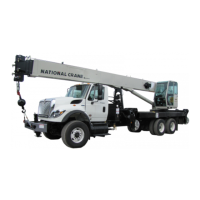
